If you have anything to do with a product, you’ll know that messaging and positioning are absolutely integral to your responsibilities. Don’t believe us? Just refer to the 92% of respondents in the State of Product Marketing Report who confirmed this to be the case. 📈
For SaaS leaders, making sure that their product is connecting with the right audience is crucial. A subscription is a long-term investment, and customers need to know that they can trust your product to fulfill their needs
Check the data from the report below.
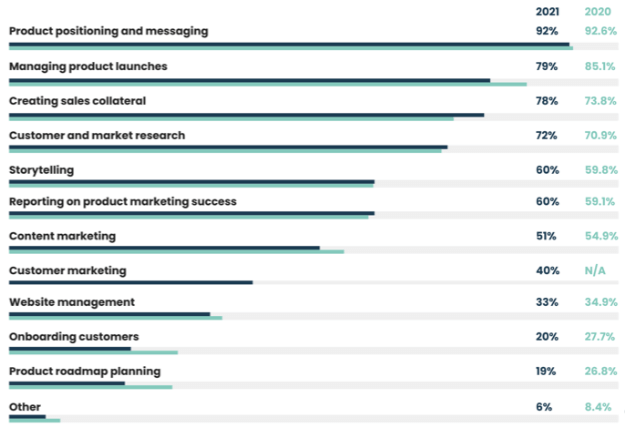
If product messaging doesn’t resonate with your customers, you’re prone to customer churn, while adoption rates could take a hit if you fail to position your product in an increasingly competitive marketplace.
Such is the importance of these areas, this piece will focus on:
- How to create compelling product messaging
- The art of product positioning
- How to combine messaging and positioning
- Product messaging and positioning resources
How to create compelling product messaging
Ashley Wood, Head Of Product Marketing at LANDR Audio Inc. gave her insights on how PMMs can refine their product messaging. 👇
What does powerful messaging look like?
“I think it's clear above all else, we have a tendency, especially for working on a product and just internally in general, to assume if people have heard about this function or this feature, that they understand the brand as a whole.
“And that's why empathy is such an important quality to have in a product marketer. Powerful messaging addresses the who, the why, the what, and the how. The why really is about helping them solve a problem, identifying what is, what your differentiators are, and the how being your features and functionalities.
“I play this really annoying game with my PMMs where I'll just ask, ‘So what?’ until we've really gotten to the core of the problem that we're solving. So they'll give a positioning statement or their primary messaging and I'll just ask, ‘so what?’, and they'll give me an answer.
We really end up somewhere where we've got the meat of the problem, and the meat of the solution, which makes the messaging a lot easier.
“I think lastly, make sure that you understand that powerful messaging doesn't stay powerful forever. Your products are evolving, your competitors are evolving, and more importantly, your users are evolving.
“It's possible that you outgrow your messaging. I think it's important that you're always checking that it's still resonating with your audience, whether that's through A/B tests, user interviews, and performance metrics.”
How can PMMs develop existing messaging?
“I think the more time you spend with users understanding their goals, their jobs to be done, the easier it is to build the messaging that resonates.
“When it comes to evaluating it and making sure that you're always combining the quantitative and qualitative data, typically quantitative findings will signal that there's an issue and then you can dig in a bit further with qualitative findings, mostly through user interviews and focus groups. If you do one without the other, this can leave too much room for blind spots.
“Landing page performance is a really good one, ads, paid ads are just a really easy, quick way to validate if your messaging is working.
“I'd say looking at performance for your quantitative and then user interviews for your qualitative will usually give you a pretty well-rounded, comprehensive view if your messaging is resonating.”

How do you highlight USPs in your messaging?
“Working on messaging without being crystal clear on the positioning is a mistake. I really like April Dunford’s framework for positioning. We use that document as a home base so we have a lot of clarity on who our competitors are in each space, how we're unique for each of them, and who cares the most about the value that those unique attributes bring.
“Once that’s set in stone for the moment we use it to come back to, and when we create messaging, we say, “OK, does this line up with our positioning document? Does this line up with our user personas and our segments?
“As I mentioned before, there is always quantitative data to consider such as performance metrics, email, click-through rates which all highlight whether you're hitting the mark or not. When you're not, then you can go back and dig through step by step where you went wrong.”
What challenges have you faced when creating messaging?
“The biggest challenge probably comes to narrowing down exactly who cares the most about the value you're providing. We have a tendency to want to communicate with as large an audience as possible.
“However, I think what usually ends up happening there is that your messaging talks to everyone without actually talking to anyone, because you've watered it down so much that it's generic and therefore, it doesn’t resonate with anyone.
“Establishing strong positioning that everyone internally is aligned on is the key to crafting successful messaging. In my opinion, when you know exactly who your product is serving, why it's the best position to solve that problem, messaging becomes a lot more instinctual.”
Which common messaging mistakes do you often see?
“One of the most common mistakes I see is when messages are so big that you don't understand what they do and who they're for.
“At Lander, there's no shortage of people who could benefit from our products. But having to take a step back and communicate that to a product manager that's spending all of their time trying to make this the most usable product for as many people, I'm letting them know, ‘I know, all of these people could care about it or should care about it, but this is the group of people we have the best shot of converting.’
“I think a common internal mistake is not clearly communicating your audience segment to internal stakeholders.”
How can PMMs create messaging that aligns with brand identity?
“To me, messaging is the outcome of positioning plus branding. It’s essential to align the expectations of the product marketing and brand teams so they understand what each product is solving for the audience.
“At Lander, we're lucky enough to have great copywriters on our brand team that take the insights and the USPs that PMM feeds them, and turn them into content that our audience wants to read and engage with.
“I think it's about providing the right insights to the right teams and making sure you're aligned right from the start.”

The art of product positioning
Product positioning is also a crucial part of a product marketing strategy. It’s a strategic exercise used to find a product or service’s place in the market.
Positioning defines what makes your product different from the others on the market so you can focus on messaging and effectively explain its value to potential customers.
Carrie Smith, Director of Product Marketing at Salesforce, outlines how the company cut through the noise with messaging and positioning to make their product unique in the eye of the customer:
I joined Salesforce about four years ago, and I started out on a cool product called Pardot. For those of you that aren't familiar with Pardot, it's our B2B marketing automation platform, and it lives inside of Salesforce.
Pardot was acquired through acquisition and before it was integrated into the Salesforce platform, it was a standalone app and you had to log in through your browser.
When I joined Pardot, back in 2017, it was an interesting time, because the engineering team was working on the code and all of the plumbing to take it from that standalone app and bring it into the platform.
During this time, it was my job to position it in the right way and figure out how to make a big splash, because we were going to launch this new product, essentially at Dreamforce.
Because this was launching at Dreamforce, we knew that we needed to nail the messaging. So, we rolled out the first round of messaging and we tested it with our trailblazers, analysts, and unsurprisingly, we didn't quite hit the nail on the head the first time.
So, we went to our platform team and I said, “what can we do with this?” It was interesting because they had a whole different way of looking at it. Their position was, “it's not just the marketing data that you're moving back and forth from Salesforce to the app, you're bringing sales and marketing together into one platform.”
At that moment, no other company could say they did that. I just remember thinking, “wow, that's a lot bigger than the app that we're currently working with.” With this in mind, that's the messaging we took and that was what we used for our launch in 2017.
The messaging worked great, and by the end of it, I kept thinking back to how flexible our products were and how we positioned them, especially when it's around software and technology. There are a lot of things you can do to not only make messaging more strategic but also emotional and fun.
That's what I focus on because we all have that opportunity whether it’s with the products that we're working on, the company we're working with, or how we're positioning the messaging for those.
To do that, I wanted to start with some of the basics of what positioning is and understand what that word means. The word ‘positioning’ is about finding that position for your product, or maybe your company inside of somebody else's brain.
Nothing sits in your brain by itself, everything is connected to something else; think about when you go to sleep at night - your brain is trying to organize your thoughts and relate all of those thoughts together. As a marketer, you need to know that because you need to find that position for your product.
For example, when I say the word ‘college’, your brain thinks of all the things you associate with your time studying at college. Maybe it was the dorm you lived in or the friends you had, or maybe even the classes or the bars that you went to. Whatever they are, you have those associations with this word and your brain brings those up because they're all connected.
Products, services, and companies work the same way. As far as product association is concerned, you can think about those associations across a multitude of different levels. I want to highlight Coca-Cola as an example.
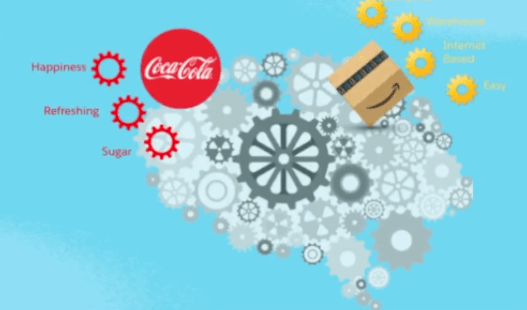
Firstly, let’s highlight the aspirational message, which is what the company wants your immediate thought to be. In the case of Coca-Cola, or Coke, it might be happiness or feeling refreshed.
Those are the words that Coke pushes on us. Then, there's the experiential association. So, things like, it might have a lot of sugar in it or it might not be that healthy. These are the things that we experience when we think about Coke.
Then, there are the influential associations. These are the things that we may be read about in the press or read about online, and these are going to give us that different set of associations, and our brain puts all of that together.
This is how you create a brand and the associations with the brand. So as a marketer, we need to understand how associations work so we can get the right words and the right language to position our product with our customers.
There’s one thing I want to highlight, because we've all either been there, or we've all seen this done, is creating a new space in someone's mind for a new category, product, or technology.

It’s hard because your brain wants to put it somewhere and associate it with something. However, it can't always do that if it doesn't know where to plug it in, and we see a lot of that with new technologies.
For example, a few years ago, Salesforce launched blockchain and I had the opportunity to meet with that team. While they were building the messaging, it was an interesting conversation, because the feedback that we got from our customers was that they weren’t sure how to associate with it.
Also about 20 years ago, when Salesforce started, there was a team that was launching the messaging around cloud CRM, and they struggled with the positioning.

That was a tough place to be in because customers were using on-premise CRM, and though it wasn’t a surprise that we were being associated with the likes of Siebel, it wasn't quite the positioning that Salesforce was looking for, because it wasn't differentiating our product enough. We wanted to move away from the on-premise that lives in our heads.
The core differentiator at the time was what we call multi-tenancy. This is the cloud, i.e. its ability to run a whole bunch of customers onto one instance of a product. That’s what set us apart and made us different.
There are a lot of benefits with that; the customers couldn't get out of their current IT space in their head that Salesforce was a CRM in the cloud because it wasn't quite what they're used to. Explaining multi-tenancy was tough, and nobody quite got that either.
Metaphor marketing
As a solution, Salesforce came up with the idea called metaphor marketing. This involves creating a metaphor for your product, technology, or your company that’s easily understandable, relatable, and desirable.
It explains what you do to associate with another brand. I'm going to walk through a few examples of that - some of our analogies and metaphors are used everywhere, so I hope you find some great news out of this.
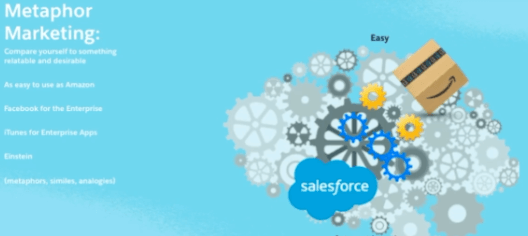
For Salesforce, that metaphor was Amazon. Just like you point to your browser and Amazon, you point to your browser and Salesforce, and you get all the benefits of that enterprise application.
For example, when you rent an apartment building, you get infrastructure, you get security, electricity, maybe you even get a swimming pool - it’s likely, you don't pay for all of that separately. When you rent an apartment building, it's easy to assume that you're renting the apartment building with all of those amenities included.
Salesforce offers the same thing. When you purchase Salesforce, it comes with real-time updates, and all of your information across all of your org is in the cloud, so you don't need to upload it. Everybody's essentially working from the same set of data.
Similarly, when I think about Chatter, I think of it as Facebook for the enterprise. Alternatively, if you've ever been on Appexchange, it is like iTunes for an enterprise app. Even when you think about Einstein, that brings a whole set of associations to what Einstein is.
Einstein’s smart, innovative, and a trailblazer. All of those associations are immediately attached to our product. When we start using those words, it's an easy way to think about positioning a product in a new space by creating these associations.
Repositioning your product
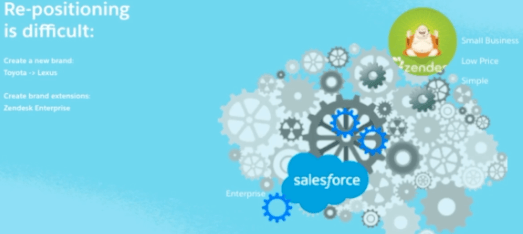
Let’s switch gears and talk about repositioning. We know that positioning any product can be tricky, it can also take a lot of time and research, and repositioning your product when it already has a position in somebody else's head can be tough, if not even tougher.
We'll do and see that a lot when technology, markets, and even we as consumers and creators evolve and change. That said, it's hard to say, “we’re not this anymore, instead, we’re this.” You've got to figure out how to move your positioning for a product when you do that.
A good example of brand repositioning is Toyota. They started out making relatively midsize cars and they created this great brand association around reliability, and it worked for them.
However, it came to the point in the company's history where they wanted to move upscale into more luxurious cars. They couldn't take their position and just say, “we’re Toyota, and now we're going to start selling luxury cars.” They couldn't do that because people just couldn't wrap their heads around a luxury Toyota.
Therefore, they created an entirely new brand called Lexus. While it’s expensive to do that, sometimes you need to shift from where you are and create a new brand around that.
So we'll see that today in our space, especially the SMB (server message block) space, Salesforce is trying to sell more SMB, but the Salesforce brand, essentially that we've created, is associated with those big enterprise Fortune 500 companies.

What we’ve done over the years is ironic because we started in the SMB space, but we've gradually moved upmarket. And so we have a lot of Fortune 500 companies, but we're trying to do that. We created a new brand, and it's called Essentials. If you're not familiar with Essentials, it’s our SMB brand for Salesforce. We use that name (coupled with Salesforce) to start creating that brand new association.
Another example in terms of associations is Zendesk. It’s incredibly easy to use, simple, is made for small businesses, and in many ways is the opposite from us in that it’s trying to move into the enterprise space. They've created Zendesk Enterprise, so it's always a challenge moving your positioning into a new space, and I’m so excited to see how they take it and where they go.
Cars and positioning
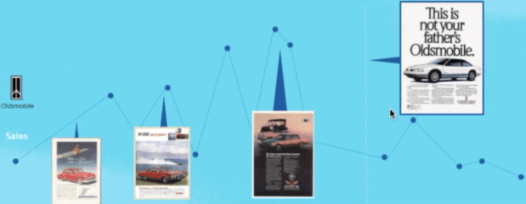
Let's talk about cars and positioning. I chose Oldsmobile because, during grad school, I spent a little bit of time dissecting their messaging and working on a project around it, so I have a little bit of insight into what I wanted to share. There's a ton of information about the repositioning campaigns online, and it's a lot of fun to read about.
I'm sure everybody has heard of Oldsmobile. I believe my grandmother even had an Oldsmobile. Around the 1950s and 1960s, they positioned themselves as fast, fun, young, and they sold a lot of cars to the younger market.
At the time, Oldsmobile cars were sporty and fun; you can see some of their ads here with slogans like, “make a date with 88”. They were trying to appeal to that younger buyer, and they did incredibly well over the years.
Then, those buyers started to age and they needed to find cars to suit their families with four doors, etc. So, as the demographic got older, the brand positioned its products differently and evolved its models. They did well and their sales kept going up over time. There were dips and recessions here and there, but every car manufacturer felt that in the early 70s and early 80s, but overall, they did well.
Eventually, they got to the point where they needed to shift and reposition themselves to grow and meet the needs of a younger audience. This is where all the growth in the industry was, and with a brand like Oldsmobile, with the word ‘old’ in their name, it was hard to appeal to this market segment.
However, they came out with a whole new brand campaign. They had print ads, outdoor advertising, TV commercials, and even coined the phrase, ‘this is not your father's Oldsmobile’. They were trying to appeal to the younger audience, but it backfired. The problem was that it was their father's Oldsmobile because that car was the same car their father probably had.
In this case, Oldsmobile didn't change the product, but they changed the marketing. This is one of the biggest learnings I think we can take from this: your positioning needs to be reinforced by the product. It’s important to know when to position and reposition a product as we want to create this position in people's heads.
There are frameworks and methods you can use to position yourself more strategically and instill emotion into what you do. how we can bring a little bit more emotion into what it is that we do.
Positioning quadrant
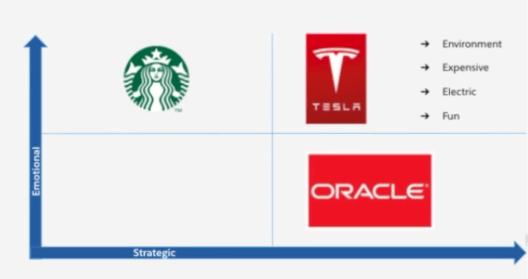
We don't always think about emotion when we sell to a buyer with technology, but this needs to be taken into consideration. We also need to think about how we can be more strategic, because when you make something more strategic, people are going to spend more money on it.
A great example of this is Tesla, in the upper right-hand quadrant of the square. I don't know if you've ever talked to somebody with a Tesla, or if you have a friend that has a Tesla.
There’s an emotional attachment there and if you visit a Tesla dealership, they'll sit and talk to you about their product for 20 to 30 minutes, explaining how the car is 100% electric, and the great things they're doing for the environment. This brand messaging matters to a lot of buyers and people pay a lot of money for that.
Associations are important to Tesla as a brand, but not everybody can be up there on the right. When you get down to the bottom right of the quadrant, there are brands like Oracle, and this technology is a little bit more strategic. CIOs spend a tonne of money on Oracle to run their businesses, so it’s an important tool.
However, if you ever read the content on their website, or maybe if you go to a keynote, it's not super emotional. And maybe if you've ever been to Oracle OpenWorld, , it's geared towards those IT folks, and that's pretty much about it, there isn't a ton of emotion behind it.
And then in the upper left-hand corner, you're going to get emotional brands, and people have a high and strong attachment to them. I consider Starbucks to be a great example of this.
I wouldn’t say they're overly strategic. Granted, some people could disagree with me and suggest that caffeine is strategic because people need it as part of their daily routine. But the brand certainly is very highly emotional and there are a lot of buy-ins when it comes to Starbucks. People love it, and they have a high affinity for it.
So, I want to switch gears a little bit. And I want to show you an ad from a company and we'll talk about it at the end. It’s an ad from Apple, and I think that they've done an incredible job at taking boring B2B technology and turning it into something that's incredibly emotional and something that we can all relate to.
Our marketing goal
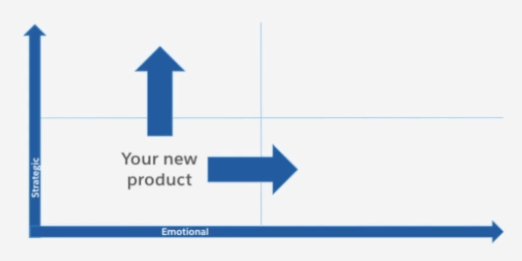
In this advertisement, you saw a little bit of Siri, an alarm clock, a lot of collaboration, and there were different types of Apple products included by themselves.
Separately, they could be considered as ‘boring technology’. However, they didn't showcase the technology. Instead, they showed how people use it and the outcome of the technology.
That's where emotion comes in; our goal is we want to get offered the ability to show the impact of your products and what it does on people's lives. With this in mind, I'm going to show you a typical framework that we use for all of our products.
Start with a positioning statement
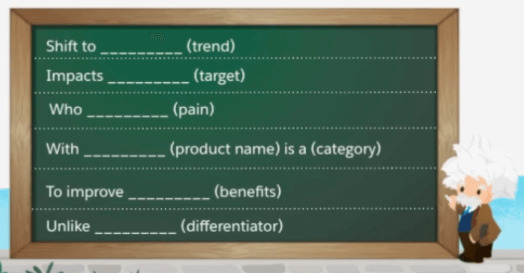
At Salesforce, there’re about five or six different frameworks we use, but I'm only going to highlight this one, and I'm going to show you how we use it to make our product more strategic and more emotional.
Firstly, I'm going to start with the positioning statement. This is tried and true in marketing. I know it probably looks a little old school, but it works well. It highlights the problem that we're trying to solve, the solution, and also the benefits that we offer.
“We must differentiate the product. I took our traditional positioning statement, which has all of these elements that we added to the top, and we call these trends or a shift. This is what takes you to where we are today with our products and makes it more relevant in terms of what's happening around the world.
I want to walk you through each one of these elements and talk to you about how to make each one more strategic and more emotional, just to give you some ideas and some frameworks around it.

Beforehand, I’m going to apply this to sales. We use this when we position all of our products and the trend that we address is the Fourth Industrial Revolution.
You can see our target is C-level executives who are disconnected from their customers, and then the solution is our customer success platform. So the benefits are sales, service, marketing, growth, loyalty, productivity, things like that.
Our differentiators are:
1) We're a company based on values, and
2) The customer success platform.
We can help you integrate and help buy into anything and everything you do. With Einstein, we're going to help with this, and give you that 360-degree view of your customer. We also have this awesome Trailblazer community, and that's going to help make you even more successful.
Those are all the little things that are going to make you different. If you look at this, this is also what we use for our pitch deck. This is essentially how we use these frameworks today. This is one of the flows that work well, so this is why I wanted to show you this framework.
Be relevant
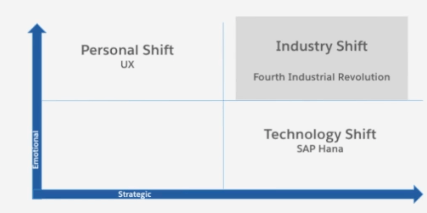
One thing I want to highlight is also relevancy. Let me start with the first part of this shift that happens today. We use the Fourth Industrial Revolution here at Salesforce because it's emotional.
When we relate this to big shifts, and I'll use the Fourth Industrial Revolution as an example, we're talking about losing jobs and the need to build new skills. This hits home for a lot of companies because they're running into this issue today, but it's also strategic because it can make a huge impact on your company.
So, if you can make this transformation, become more connected to your customers, and integrate intelligence in everything you do, then Salesforce is going to take you on that path.
In the lower right, most technologies, and I think SAP is a good example, are strategic, but they're not that emotional. It's something maybe a CIO might get a little emotional about, but it's a technology.
Then, in the upper left-hand corner, you're going to get things in technology like a user interface (UI) shift. This can be extremely emotional, especially for people that might work inside maybe a ton of different browsers with a ton of tabs open, and they can never quite find what they're looking for. It’s up to us to take those users and explain how it can be beneficial.
Your target drives positioning
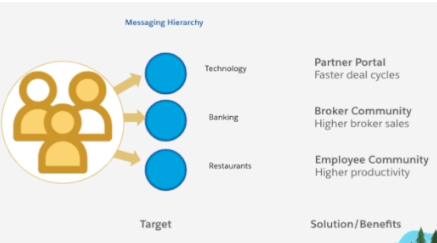
Salesforce Experience Cloud can be sold to a partner manager at a tech company by saying, “this is going to power your partner portal.” I can talk about closing deals faster with partners and take that same technology, and sell it to somebody in the financial services industry.
They can use it to power their broker community. I can also take that same product and position it to somebody that might work in HR, who’ll use it to help their employees collaborate and be more productive.
Each of these use cases requires different messages, benefits, and different buyers. But overall, it's the same technology. In a situation like that, you need to create a messaging hierarchy of what the core positioning is for your products, and then how to map to those different use cases.
This is a good place to be in because it gives you a lot of options of where you can sell, and the highest level of how you position that. As soon as you have your target, here's where I think you can start adding more emotion into how you're positioning, what you're selling.
Increase emotion through pain
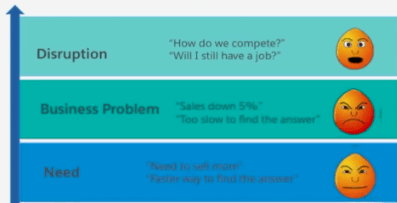
Look at emotion like a great starting point: what is the pain for your product? What is the problem that you're addressing?
I've seen a few positioning statements that say “I need this”, or maybe “I need to sell more”, or “I need to work faster”, “I need to find answers faster”. However, those are needs, as opposed to pain points. Therefore, it's not that emotional.
However, if you can convert that pain into something like, “my sales are down 5% and I need to sell more”, that's more than likely going to resonate and hit on something that might affect someone's job, or possibly that they need to do something different in their role, and that's closer to where you want to be.
You need to be able to address pain as a disruption in someone's business. If you're selling into retail and you bring up Amazon, that's probably going to bring up a lot of angst for a customer, because a lot of companies are having a tough time competing with Amazon.
The mention of Amazon and talking about it’s probably going to get you a foot in the door and possibly a conversation with a customer because the impact on their company is real.
So, that's a pain that affects an entire business - not just someone's job, or someone's department. Think about that, and how emotional you can get as you start to position your products.
Strategic product positioning
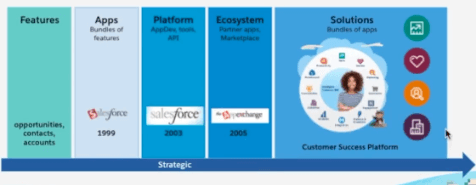
You've identified the pain, and now you want to show a solution. This is the point when you're going to start to get more strategic and this goes back to that open example I had around, is it an app? Is it a platform? Is it a marketplace?
This prompts the question: what do you think about that spectrum? I think at the lowest level of being strategic, we can market our features and our products. When we started Salesforce, we had a bunch of different features. It was accounts, opportunities, and contacts - that's essentially all it was.
Through time, it started to become an application. We had more workflow, more processes, we sold applications, which was obviously more strategic than just selling features.
As we evolved, we started to open up those apps with application programming interfaces (APIs), developer kits, and we became a platform. This was much bigger because now customers and partners could start building things on our platform. We opened up new revenue streams for other companies, the ecosystem around us became even bigger and more strategic.
Once that started happening, we were able to create that marketplace. There was a whole economy around Salesforce and the AppExchange and companies building and selling products that they have now and they have new ideas for, so it becomes even more powerful than what our apps even could have been, or even what our platform could do, so it grew tremendously over time.
Today, I think we're at a point where we're becoming even more strategic in that we talk about solutions and think about solutions encompassing everything below this.
For selling into sales, service, or marketing, a solution needs to include some apps, probably the platform, a partner ecosystem where partners can plug into and discover things their company is missing.
It's up to us to figure out how to package that together and how to talk about it in the right way for a person who has pain or a problem. This is where we're going and that's where we're going to help solve those solutions for them.
Align benefits to solving a pain
In industries, we can take this by a line of business but this is the next step for Salesforce, how we think about what we want, how we think about all these components, and how they work together.
Once you've identified those solutions, you want to go down the path and figure out what are the benefits of the solution. This is where we go back to that emotion again, and at the lowest level, the solution we have is the metrics for the business that make improvements.
For example, “30% faster”, or “10%, more productivity” are all great metrics to solve your problem. That said, they aren't that emotional, so it's solving a business problem, but no one can relate that to a person. When we can bring more emotion in, that's when we can start to talk about the achievements that we can help people deliver with our products.
When we incorporate that emotion, this is where our Trailblazer marketing goes, “this is where we identify those people, how they use Salesforce, and how those Trailblazers have made an impact on their department or their company, and all of the people we work with”. It gets more emotional and more relatable to the people in the business.
Finally, if we can address that level of transformation, connect customers, and blaze trails for them, that's the highest level of value that we can deliver where companies or people are making an impact on an entire company, or even an entire economy. That’s where those huge amounts of benefits lie.
Ideally, all three of these work together into your positioning and you can have that product level that delivers the metrics at a personal level and makes people successful at a higher level.
Strategic product positioning
Now, you're helping a company achieve some business value. So think about how to weave all of those things together to position your products. Then finally, the most important part of this is differentiation.
Price
Sometimes, our lead message is, “we work in competitive markets today, we need to be different, and we need to show our difference.” You can differentiate on price, and reduce your product, however, the danger is that your competitor follows suit and does the same thing.
Very few companies can use their pricing strategies to differentiate well. For example, Walmart competes on price.
But they've also built a company and a supply chain that's the lowest in the industry and they've built a culture at the company where everybody knows that they need to get the cheapest price out of their vendors. They’ve probably done that better than anyone else.
So they have that advantage there with that, but it's not something that most of us want to do.
Features
After price, you can differentiate on features, and tell your target audience, “we have this feature, they don't, here's our demo”, and then you can show that, and that works for a little bit.
However, a time will come when your competitor conducts competitive intelligence and figures it out. They can put a demo together and they can build the feature.
Performance
It’s more interesting when you start to compare the performance of your product with market alternatives.
This tactic is used a lot amongst hardware vendors. Whatever it is, or whatever it takes, it's hard to get to that place because you need a working product that an analyst can verify that performance.
Benefits
Similarly, you can think about the performance in terms of business benefits. For example, “20% higher revenues with Salesforce” or “10% higher customer loyalty”.
We have customer proof points that customers have shown what they've done. This is a great differentiator because it takes companies a long time to get there. If you have the product in use, showcase it, then validate it, and be willing to speak about it. That's going to help tremendously.





